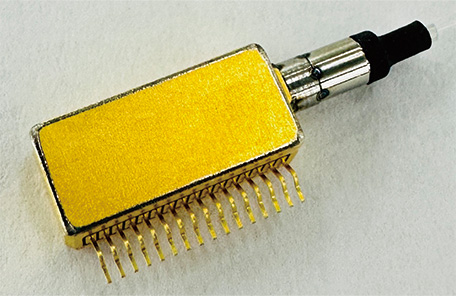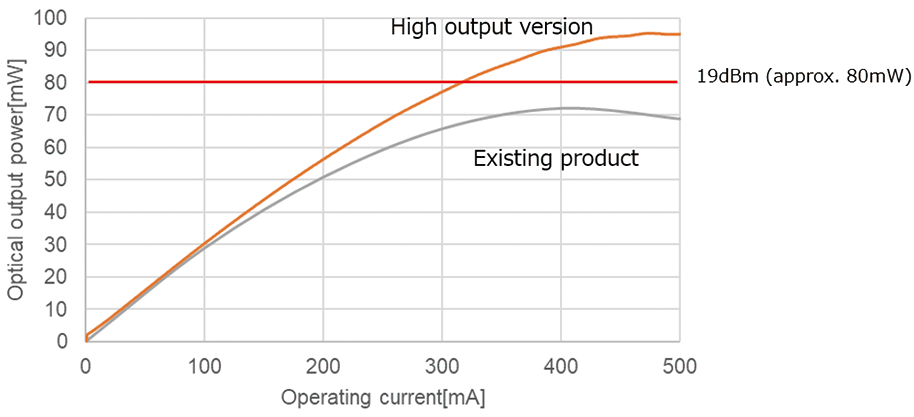Achieved a 19 dBm high output of the ultra-small, narrow linewidth tunable light source for optical digital coherent communications
- By increasing optical output power and reducing linewidth, realized progress toward early implementation of the next-generation standard 800ZR -
- Increased optical output power by 27% to 19dBm by optimizing the drive conditions and increasing the laser chip efficiency
- Along with increasing the optical output power, realized a linewidth of 150kHz, which is important for digital coherent communications
- Will exhibit the new product at OFC 2024 scheduled to be held in the United States and plan to begin shipping samples from June 2024
Furukawa Electric Co., Ltd. (Head office: 2-6-4 Otemachi, Chiyoda-ku, Tokyo; President: Hideya Moridaira) has achieved a 19dBm (approx. 80mW) optical output power from the ultra-small, narrow linewidth tunable light source , a laser product used as a light source in optical digital coherent communications (Fig. 1).
Background
Following the recent appearance of generative AI (Artificial Intelligence) and machine learning, data traffic at data centers and other locations has exploded globally, and it is expected to grow further in the future. In response to this situation, progress is being made toward the introduction of 800G ultra-high speed transmission systems using optical digital coherent communications. In particular, in relation to the next-generation telecommunications standard 800ZR (note), there are expectations for increased optical output power from the narrow linewidth tunable light source and other developments.
Details
By optimizing the waveguide design through the use of our crystal growth, precision optical semiconductor processing and other laser manufacturing technology accumulated over the past 20 years, we succeeded in increasing the optical output power from the narrow linewidth tunable light source. Compared to the existing product’s optical output power of 18dBm (approx. 63mW), it was possible to increase the optical output power by 27% to 19dBm (approx. 80mW) (Fig. 2) by optimizing the drive conditions and increasing the laser chip efficiency. Along with increasing the optical output power, we realized a linewidth of 150kHz, which is important for digital coherent communications (Table). Increasing the optical output power and reducing the linewidth will contribute to progress toward the early implementation of 800ZR, as well as increased performance through the use in products designed under the existing 400ZR standard.

We will exhibit this new product at OFC 2024 scheduled to be held on March 26-28, 2024 in San Diego (OFS Fitel, LLC booth; Booth number 2041) and plan to begin shipping samples in June 2024.
Going forward, we will continue to achieve further advances in optical lasers and contribute to the establishment of socially and environmentally friendly networks that support progress of the telecommunications society.

| Existing product | Newly developed product (High output version) |
|
|---|---|---|
| Frequency range (THz) | 191.300 - 196.100 | |
| Optical output power (dBm) | 18 | 19 |
| Linewidth (kHz) | <150 | |
| Dimensions | 5.6x12.1x3.8mm (excluding the fiber part) | |
(note) Standard set forth by the industry association OIF (The Optical Internetworking Forum) for transmission distance exceeding 80km and data transmission speed of 800 Gb/s. The current standard is 400ZR.
Related News Release
Furukawa Electric Group’s efforts towards the SDGs
Based on the “Sustainable Development Goals (SDGs)” adopted by the United Nations, Furukawa Electric Group has formulated the “Furukawa Electric Group Vision 2030” which sets the year 2030 as its target and is advancing efforts with the aim to “Build a sustainable world and make people’s life safe, peaceful and rewarding, Furukawa Electric Group will create solutions for the new generation of global infrastructure combining information, energy and mobility.” Toward the achievement of our Vision 2030, we will take open, agile, and innovative approaches to promote ESG management that aims to increase corporate value over the medium to long term and will contribute to the achievement of the SDGs.







 Share
Share Tweet
Tweet Share
Share